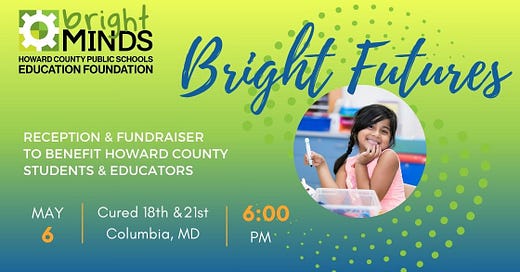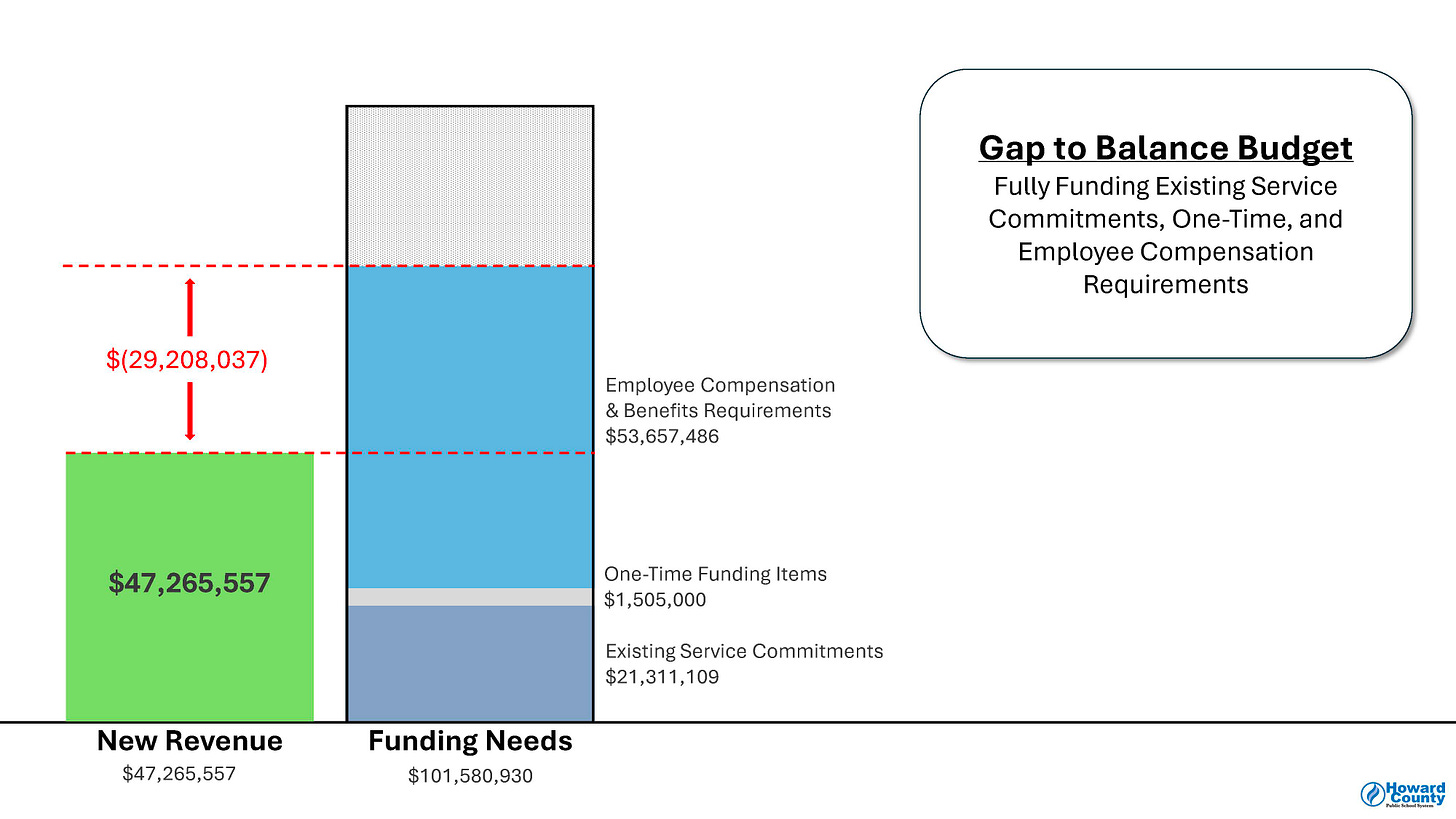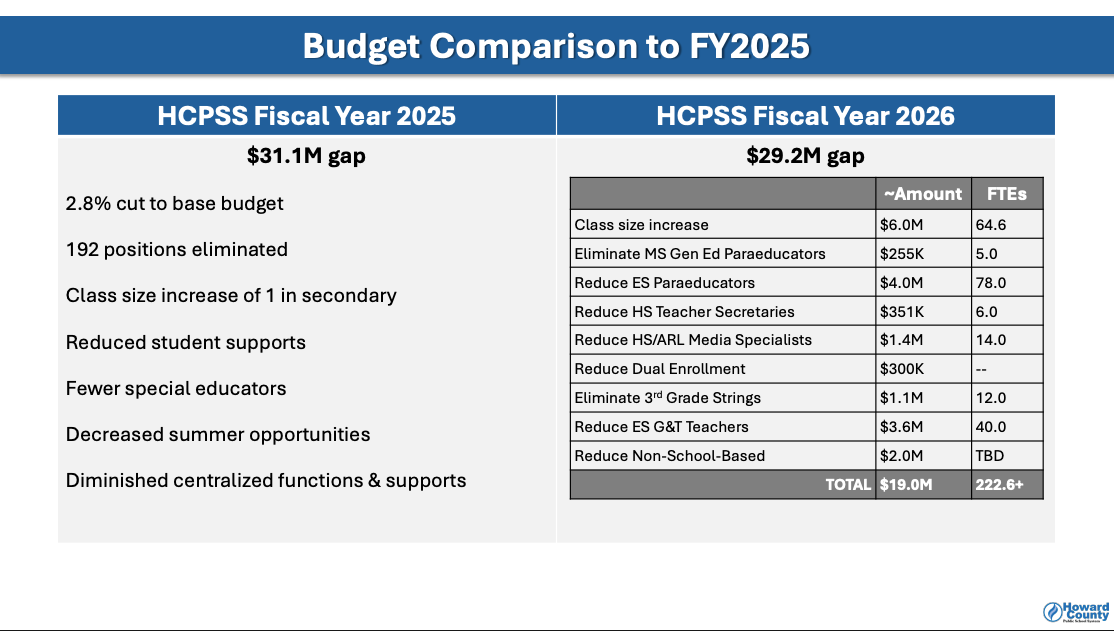Baked‑In Shortfalls: How Howard County’s Budget Choices Undermine Its Public Schools
Fundraisers like Bright Minds fill headlines—but not billion‑dollar holes left by development policy, debt service, and chronic under‑funding.
Bright Minds: A Symptom, Not a Cure
On May 6, 2024, an organization called the Bright Minds Foundation held a reception and fundraiser to benefit Howard County students and educators. The event’s description stated that, “[a]ll proceeds of this event will support Bright Minds programs focused on improving education outcomes for all Howard County students.”
Bright Minds Foundation was “incorporated in 2006 by the Board of Education to improve community support for education and increase access to diverse funding for educational resources that would not be possible through the public funding of education alone.” (Emphasis added). In a 2024 testimony to the Board of Education, the foundation requests an increase in funding to help the organization “better help the school system with its funding gaps and priorities.”
Budget “Success” vs. Classroom Reality
Last year, this annual event took place during a highly contentious budget process during which, on the one hand, the County Executive claimed that the school system’s funding needs were met “without compromising services” and on the other, teachers, community members and certain school board members raised alarms about cutting music, special education, and gifted and talented programs.
There is a fundamental disconnect in our county government. While policymakers make bold claims that the schools are getting funded at “historic” levels by offering misleading metrics as proof such as “maintenance of effort” or “enrollment levels,” they establish and fund non-profit foundations that are perpetual indictments of the county’s failure to meet the school system’s needs. This is not a criticism of the volunteers who serve in the foundations because they care for the welfare of our society’s future - its children. In fact, one would hope that they would call for full funding of the schools in order to obviate the need for such foundations and allow those volunteers to spend their time and energy in other important causes.
The Achievement Gap and Resource Allocation
Race, Income, and Academic Outcomes
The achievement gap is largely a function of race and income, which are highly correlated. The school system’s data show that black and hispanic students lag significantly behind other races and economically disadvantaged students also face those same challenges. This figure shows a linear regression of academic achievement scores and percentage of black student population in HCPSS elementary schools for 2024 pulled from state MSDE data. Given the correlation of race and income, a higher concentration of economically disadvantaged students leads to lower overall scores in the schools.
In a school system with an operating budget of hundreds of millions of dollars, there is no way that a few hundred thousand dollars raised annually would help fix the issue. They serve mainly to mask structural under-funding. I will elaborate more down below. Before I do that, I want describe a few additional challenges that schools face.
Special Education Staff Shortages
Earlier this year, a WBAL-TV investigation documented the scandalous levels of underfunding and neglect that exists in the school system’s special education program. According to the report, “five of the last 10 school years saw a decrease in per-pupil special education funding, including decreases in 2023-24 and 2024-25.” Furthermore, “69% of 116 school-based staff vacancies are in special education.”
Consequences of Deferred Spending
The Athletic-Trainer Tragedy
Meanwhile, for several years, parents of student athletes raised alarms about the lack of athletic trainers in high schools to tend to student athletes. In an April 2024, Baltimore Sun article, one high school coach described it as “an atom bomb waiting to go off.” This fear was proven prescient.
One year later, in January 2025, a mother of a high school student sued the school system after her son became a quadriplegic when he suffered from a heart attack during a January 2024 basketball practice. The news report states that the student remained unresponsive for “about 15 minutes without medical attention.” In her law suit, she alleges that “school staff violated her son’s rights to bodily integrity and due process in failing to take precautions and administer emergency medical aid.”
Arguably, this was preventable. In 2023, then-superintendent Martirano included funding to the FY 2024 operating budget, which would have hired 13 full-time athletic trainers for each high school. According to the 2024 Baltimore Sun article, in February 6, 2023, Howard County Director of Athletics Jack Davis explained in a BOE work session the various ways athletic trainers are vital including providing life-saving measures. He referenced an anecdote where Buffalo Bills athletic training staff saved the life of a player after he went into cardiac arrest on the field.
What is at Risk Going Forward - 2025 Budget Gap and Program Cuts
According to the Board of Education’s April 29, 2025 work session, the school system needs a minimum of $29.3 million to cover the budget short-fall, which would support “fully funding EXISTING service commitments, one-time, and employee compensation requirements.”
Note that closing this budget gap does not imply “fully funding the budget” as that would entail addressing years of accumulated deficit due to years of underfunding. Nevertheless, what are the consequences of not closing the budget gap? The school system says cuts will increase class sizes, eliminate Paraeducators, cut third‑grade music, and scale back gifted‑and‑talented programs.” This would mean eliminating at least 222.6 full time equivalent positions.
The high school athlete who suffered a cardiac arrest in 2024 during a basketball practice will live as a quadriplegic for the rest of his life largely due to an intentional policy decision the county and Board of Education took several years before, including and up to 2023. Many more students will be harmed in 2026 and beyond because of this year’s harmful policy choices; Black and Hispanic children, particularity those from economically disadvantaged families and children with special needs, will see their achievement gaps widen as the county continues to slash funding, enlarge class sizes, and cut critical services and programs.
Why the Pie Keeps Shrinking
Howard County’s school budget woes are the result of intentional policy decisions that inflict harm on the county’s most vulnerable. The impacts of these decisions materialize long after these decisions are taken. In other words, by the time the budget discussions take place that pie is already baked. Invariably, community advocates, the teachers union, and other entities scramble to fight over a fixed pie every year.
There are alternatives to having the same budget fights, year-in, year-out. It would entail proactive advocacy on county policies and I offer a few suggestions below.
Debt Service and Development Policy
For several years, Howard Count’s budgeting process has relied on a major fatal assumption - that residential development pays for itself. This assumption needs to change. This policy assumption alone has cost the county hundreds of millions of dollars in revenue. As a result the county issues anywhere from $80 to $100 million in new bonds and spends around $100 million to pay for financing old debt. This trend shows no signs of changing. The next general plan, HoCoByDesign makes the same fatal assumption and will lead to an additional $500 million in new debt by 2040.
The Myth That “Residential Development Pays for Itself”
The following is an excerpt from the county’s general plan HoCoByDesign where the county asserts that “new residential development pays for itself.” This is pure gaslighting and is equivalent to claiming that night is day and day is night. Residential development has never paid for itself and the county’s budget is living proof of that.
While the county’s general plan projects surpluses in the county’s annual budget for the 18 year window of projection, the so-called spending affordability advisory committee’s FY2026 report projects staggering and unsustainable levels of funding gaps by 2031.
Furthermore, the county needs to stop making the school system an afterthought. In the last general plan, it was not until the community spoke up that the county included a chapter on schools, which unfortunately, fell significantly short of addressing how the county will address overcrowding and deferred maintenance. The county has made the same error again when it failed to address schools meaningfully in the Columbia Gateway Masterplan.
Costly Amenities for Howard Hughes Corporations
Performing Arts Center, Central Library Parking Garage
The county must cease funding all forms of projects intended to provide amenities that will raise the property value of Howard Hughes Corporations using taxpayer dollars. The two such examples are the so-called Performing Arts Center and the Central Library. If Howard Hughes Corporation wants to build amenities to help its property value, it should pay for it.
In March 2025, the County Executive sent a request to the County Council to “release of $5 million in State funds that were received in Fiscal Year 2024 and are currently held in contingency, in his Fiscal Year 2026 capital budget to support the County’s efforts to finalize plans for a new Howard County Library System Central branch in Downtown Columbia.” The cost of this project is expected to be at least $150 million.
In April 2025, the County Executive broke ground on a so-called “Performance Arts Center” a $69 million boondoggle project in Downtown Columbia.
Instead of allocating money for the $150 million garage project that would benefit Howard Hughes Corporation, we need to focus on investing more on our schools.
APFO and Land-Use Loopholes
The county continues to see zoning and land use decisions that do not meet the needs of our community. Practices such as "fee in lieu" and insufficient planning and zoning fees allow developers to bypass the full costs of infrastructure, which should include adequate educational facilities. We have seen efforts to undermine the Adequate Public Facilities Ordinance (APFO) during the last general plan, which continues to this day with the currently constituted APFO committee.
The 2025 APFO Committee’s first motion made by a committee member, who happens to be the Chair of the Spending Affordability Advisory Committee was to eliminate school adequacy tests from APFO. A snap shot of the motion sheet shows that subsequent measures provide stronger protections for schools failed.
Notably, the APFO committee is represented by school board member Jen Mallo, who voted “No” on those protection measures. Meanwhile, in a work session, according to a Baltimore Banner article, she said “We can’t fund everything…[s]o what are the tradeoffs? What are we willing to give up?”
Moving Beyond Philanthropic Band-Aids
The Bright Minds Foundation’s next fundraiser will be held on June 11. This well-intentioned initiative, which was established in 2006 - 19 years ago - is a constant reminder that for at least 19 years, the school system has failed to meet the needs of its most vulnerable in a meaningful way. On its website it touts raising nearly $3.8 million in 19 years, which is an incredible feat, especially since it operates with limited resources.
Non-profits serve a critical purpose in our society, not the least of which is for the good they do. According to the book The Revolution Will Not Be Funded, the nonprofit industrial complex (NPIC) “functions as an alibi that allows government to make war, expand punishment, and proliferate market economies under the veil of partnership between the public and private sectors.”
Many of these nonprofits are largely operated by individuals whose children will not need the programs provided by the foundations and if they do, the funding relies on the benevolence of those whose do not. Ultimately, those with economic and political power have an outsized influence on those foundations. To the extent that those who control the resources want to help the marginalized they would prefer to do so without affecting their own perceived self-interest. These foundations provide that avenue for well-heeled donors.
The community knows that the state of our society is not okay and it is not willing to do what is necessary to offer radical and transformative change to fix it. The foundations help those with economic and political power “sleep at night” by providing reassurance that they are “doing all they can.”
Conclusion
Howard County can no longer paper over structural shortfalls with bake sales and benefit galas. If policymakers refuse to curb developer giveaways, reform APFO, and close the $29 million gap, more students—especially Black, Hispanic, and special‑education learners—will pay the price. It’s time to fund schools first and let philanthropy be a bonus, not a lifeline.












